Total number of constructions increased by 26 percent
The number of constructions from approved building permits in Davao de Oro increased to 3,258 in 2022. This is higher by 26.2 percent compared with the 2021 output of 2,582 constructions. (Table 1)

Construction of residential buildings still had the highest number
Of the types of construction, residential type recorded the highest number at 2,728 or 83.7 percent out of the total constructions in the province. Compared with the output in 2021, the number of residential constructions in 2022 was 54.4 percent higher. Moreover, 2,697 or 98.9 percent of the total number of residential buildings are singletype. This was 1,675 or 94.8 percent of the total number of residential constructions in 2021. (Table 1 and Figure1)

Meanwhile, non-residential constructions, which accounted for 493 or 15.1 percent of the total constructions posted a decrease of -26.9 percent, from the 674 building constructions recorded in 2021. (Table 1 and Figure1)
For the year 2022, the top three municipalities with the highest construction statistics contribution were Mabini with 740 buildings constructed or 22.7 percent share, followed by Nabunturan with 690 building constructions or 21.2 percent, and Laak with 433 constructions or 13.3 percent. (Figure 2)

Meanwhile, the top three municipalities for the year 2021 were Nabunturan with 537 constructions or 20.8 percent share out of the 2,582 total number of constructions. This was followed by Monkayo with 489 constructions or 18.9 percent, and Mabini with 390 or 15.1 percent share.
The Municipality of Laak reported the highest increase in the number of approved building permits at 324.5 percent or 433 building permits in 2022 compared with the 2021 output of 102 approved building permits. It was then followed by Mabini and Maco with an increase of 89.7 percent and 29.0 percent, respectively. (Figure 3)

On the other hand, Monkayo recorded the highest decrease in terms of the number of approved building permits issued at -37.4 percent, from 489 in 2021 down to 306 building permits in 2022. It was then followed by Mawab with -25.9 percent decrease and Pantukan with -16.9 percent decrease.
Average value per construction decreased by 20 percent
The average value per construction in 2022 was PhP 613,321 while in 2021, it was PhP 767,484. The value decreased by PhP154,163 per construction or a growth of -20.1 percent. (Table 2)
For residential buildings, the average value per construction was PhP 208,197. This was estimated at PhP 245,495 for the previous year. This translates to a value decrease of -15.2 percent or a decrease of PhP 37,299 per construction. (Table 2)
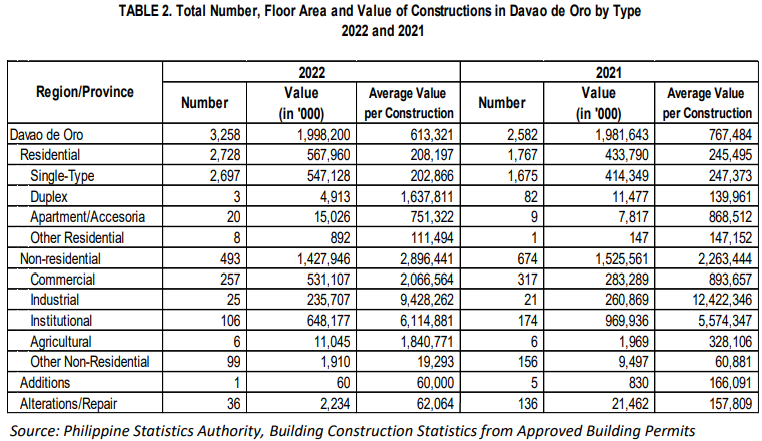
As to the type of residential constructions, Single, Apartment/Accessoria, and other residentials posted a decrease in their average value per construction in 2022 at an estimated value of PhP 202,866, PhP 751,322 and PhP 111,494, respectively. These shows a decline of 18.0, 13.5 and 24.2 percent, respectively compared to the same quarter of the previous year. (Table 2)
For Non-residential buildings, the average value per construction during the year was estimated at PhP 2.89 million while in the previous year, it was estimated at PhP 2.26 million. The value increased by PhP 632,998 per construction or an increase of 28.0 percent. (Table 2)
As to the type of Non-residential construction, Industrial buildings posted the highest average value per construction of PhP 9.43 million, followed by Institutional buildings at PhP 6.11 million and Commercial buildings at PhP 2.07 million. Meanwhile, the same trend was also observed in 2021 with Industrial, Institutional, and Commercial buildings recording the average value of construction of PhP 12.42 million, PhP 5.57 million, and PhP 893,657, respectively. (Figure 5)
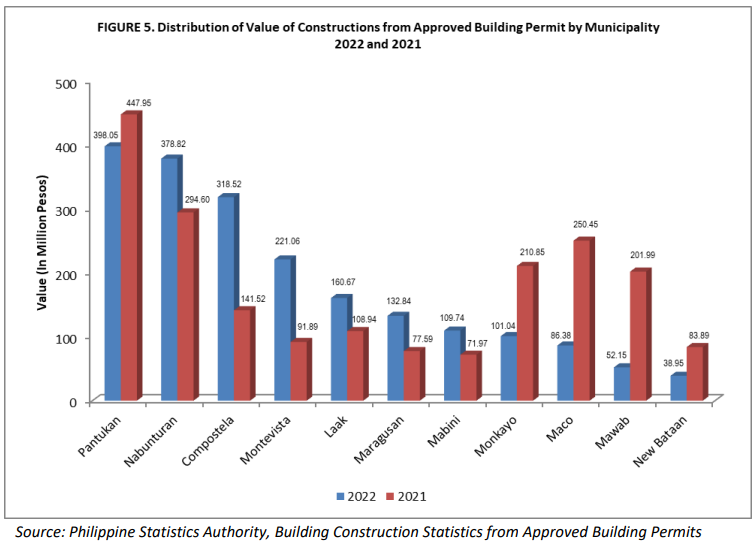
Comparing municipalities within the province, Pantukan recorded the highest average value of PhP 398.05 million, followed by Nabunturan with PhP 378.82 million, and Compostela with an average value of PhP 318.52 million. On the other hand, New Bataan reported the least average value per construction of PhP 38.95 million. (Figure 5)
Average cost per square meter of residential-type construction increased to Php 5,596
The average cost per square meter of residential construction in 2022 was estimated at PhP 5,596. This increased by 0.81 percent or Php 45, compared with the same quarter of 2021 average cost of PhP 5,551. (Table 3)
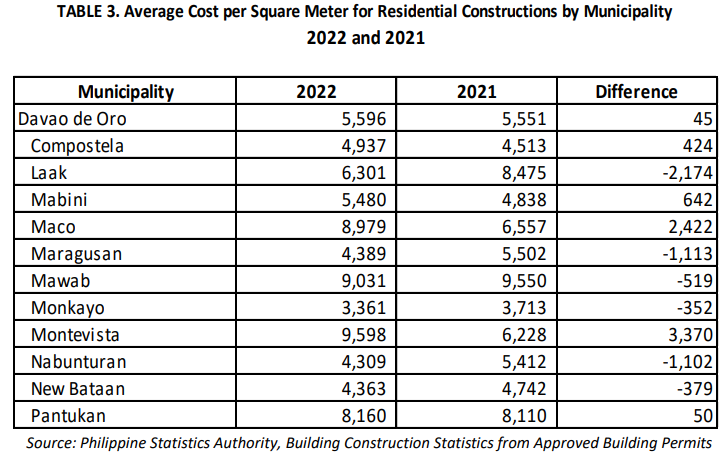
Single-type residential constructions recorded an estimated cost of PhP 5,546 per square meter in 2022. This was estimated at PhP 5,532 in 2021 or an increase of PhP 13 per square meter. (Table 3a)
It is noted that Mawab has the highest cost per square meter for Single-Type Residential building with an average cost of PhP 9,841 per square meter, followed by Montevista with PhP 9,631 per square meter, and Maco with an average cost of PhP 8,979 per square meter. Monkayo has the least cost per square meter at PhP 3,361. (Table 3a)
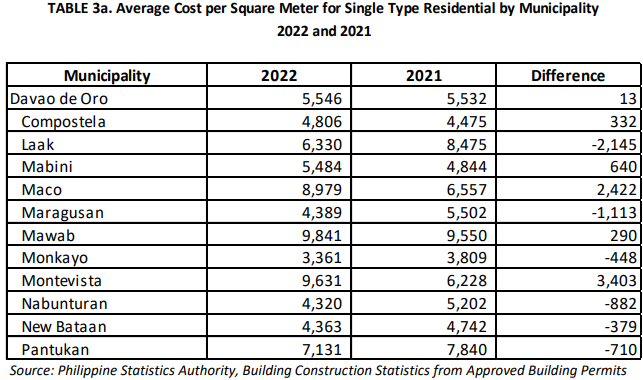
Average cost per square meter of non-residential constructions increased to Php 16,483
The average cost per square meter of non-residential constructions was recorded at PhP 16,217. This was 14.6 percent higher than the estimated cost of PhP 14,146 in 2021. This shows an increase of PhP 2,071 in average cost per square meter. (Table 4)
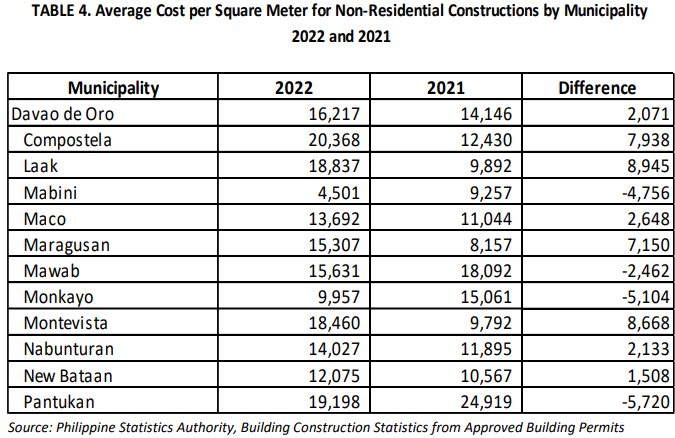
Industrial-type buildings posted the highest average cost per square meter at PhP 26,935, among the non-residential constructions. This was followed by Institutional and Commercial constructions with an average cost of PhP 20,306 and PhP 11,524, respectively. Meanwhile, Agricultural Building constructions posted the least cost per square meter with a value of PhP 8,568 in 2022. (Table 5)

TECHNICAL NOTES CONSTRUCTION STATISTICS FROM APPROVED BUILDING PERMITS
Introduction
This Special Release presents the preliminary data on construction statistics from approved building permits for the Third quarter of 2022.
Scope and Coverage
Construction statistics from approved building permits relate to administrative-based data on new constructions and additions, alterations and repairs of existing residential and non-residential buildings and other structures within Davao de Oro province.
Sources of Information
Construction statistics are compiled by the Philippine Statistics Authority (PSA) from the copies of original application forms of approved building permits as well as from the demolition and fencing permits collected every month by PSA field personnel from the Offices of Local Building Officials (LBOs) nationwide.
Limitations
1. Data on building constructions refer to those approved applications during the reference period and not to construction work completed during the reference period.
2. The completeness of the number of building permits collected relies on the approval of applications filed with the LBOs. Hence, private building constructions without approved building permits are excluded in the tabulation of data.
Geographic Classification
Building constructions are classified and presented by geographic area using the Philippine Standard Geographic Code (PSGC) as of December 2017. The PSGC contains the latest updates on the official number of regions, provinces, cities, municipalities and barangays in the Philippines.
• number
• floor area
• type of construction
• value of construction
The preliminary tables are revised to include building permit documents received after the cut-off period in the annual tabulation.
Statistical Tables
The statistical tables are presented at the regional and provincial levels by type of construction and by period according to form of ownership.
Unpublished Data
Aside from the preliminary tables posted in the PSA website, the annual, quarterly and monthly statistical tables at the municipality level by type of construction and by form of ownership are available at the Industry Statistics Division (ISD) under the Economic Sector Statistics Service (ESSS) of the PSA.
Other special tabulations may also be made available upon request, addressed to the Undersecretary, National Statistician and Civil Registrar General, Philippine Statistics Authority, 2nd Floor PSA-TAM Building PSA Complex, East Avenue, Diliman, Quezon City.
Dissemination
Preliminary and final results of construction statistics are made public in the form of Quarterly Special Releases posted in the PSA website (www.psa.gov.ph) 65 days after the reference quarter and Annual Special Release, eight months after the reference year. The Quarterly Special Releases are reports containing the preliminary results of construction statistics generated 60 days after the reference quarter while the Annual Special Release is a consolidated report of the quarterly preliminary data, including data from documents which were submitted after the cut-off dates for each quarter.
Definition of Terms (Adopted from the Revised and Updated IRR of the National Building Code)
Building permit is a written authorization granted by the LBO to an applicant allowing him to proceed with the construction of a specific project after plans, specifications and other pertinent documents have been found to be in conformity with the National Building Code (PD 1096).
Building refers to any independent, free-standing structure comprised of one or more rooms or other spaces, covered by a roof and enclosed with external walls or dividing walls, which extend from the foundation to the roof.
Construction refers to all on-site work done from site preparation, excavation, foundation, assembly of all the components and installation of utilities, machineries and equipment of buildings/structures.
Residential building is a building for which its major parts or more than half of its gross floor area is built for dwelling purposes. This type of building can be of the single type, duplex, an apartment and/or accessoria and residential condominium.
Single house is a complete structure intended for a single family or household, i.e. bungalow, 2-storey house, nipa hut.
Duplex house is a structure intended for two households, with complete living facilities for each; it is a single structure divided into two dwelling units by a wall extending from the floor to the ceiling.
Apartment is a structure, usually of two storeys, made up of independent living quarters, with independent entrances from internal walls and courts.
Accesoria is a one or two-floor structure divided into several dwelling units, each dwelling unit having its own separate entrance from the outside.
Residential condominium is a structure, usually of several storeys, consisting of multiple dwelling units.
Other residential construction consists of school or company staff houses, living quarters for drivers and maids, and guardhouses.
Non-residential building includes commercial, industrial, agricultural and institutional buildings.
Commercial buildings refer to office buildings and all buildings which are intended for use primarily in wholesale, retail and service trades; i.e. stores, hotels, restaurants, banks, disco houses, etc.
Industrial buildings are all buildings used to house the production, assembly and warehousing activities of industrial establishments; i.e. factories, plants, mills, repair shops, machine shops, printing press, storage plant, electric generating plants.
Institutional buildings are buildings which primarily engaged in providing educational instructions and hospital/health care; ports, airports and other government buildings; i.e. school, museums, libraries, sanitaria, churches, hospitals.
Agricultural buildings are buildings used to house livestock, plants and agricultural products such as barn, poultry house, piggeries, stables, greenhouses and grain mill.
Other non-building constructions include cemetery structures, street furniture, waiting sheds, communication towers, etc.
Addition refers to any new construction which increases the height or area of an existing building/structure.
Repair is a remedial work done on any damaged or deteriorated portion/s of a building/structure to restore its original condition.
Renovation is any physical change made on structures to increase the value, quality and to improve the aesthetic.
Alteration is a construction in a building/structure involving changes in the materials used, partitioning and location/size of openings, structural parts, existing utilities and equipment but does not increase the overall area thereof.
Conversion is a change in the use or occupancy of structure or any portion thereof, which has different requirements.
Demolitions refer to the systematic dismantling or destruction of a building/structure, in whole or in part.
Street furniture are street structures consisting of monuments, waiting sheds, benches, plant boxes, lampposts, electric poles and telephone poles.
Floor area of building refers to the sum of the area of each floor of the building measured to the outer surface of the outer walls including the area of lobbies, cellars, elevator shafts and all communal spaces in multi-dwellings. Areas of balconies are excluded.
Total value of construction refers to the sum of the cost of building, electrical, mechanical, plumbing, and others. The value is derived from the approved building permit and represents the estimated value of the building or structure when completed.
